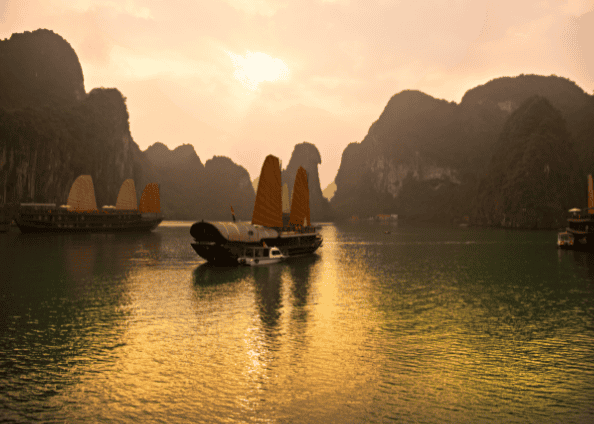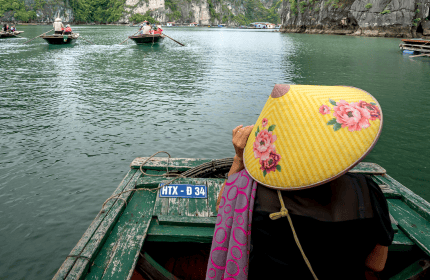

Vietnam Travel Guide
Before you pack your bags and set off on your Vietnam adventure, have a read of our handy travel guide which will fill you in on everything you need to know to prepare for your trip to Vietnam and squeeze more out of the experience.
Best ways to experience Vietnam
Planning your trip to Vietnam can be a challenge. From bustling markets and streetscapes to tranquil rice fields, ancient temples, historic sites, intriguing architecture and unique cultural encounters, there really is so much to experience in Vietnam.
It’s only natural to want to sample a bit of everything, but if you’re constrained by time, here are a few favourite experiences that are well worth trying to include on your Vietnam itinerary.
- Visit the Cu Chi Tunnels near Ho Chi Minh – This extensive underground network of tunnels dug by Viet Cong soldiers during the Vietnam War as a way to move around undetected and launch surprise attacks served as a strategic military base, as well as providing living space for soldiers with storage rooms, sleeping quarters and even makeshift hospitals. Today, visitors can explore a portion of the tunnels and gain an insight into the harsh conditions faced by the soldiers and the innovative guerrilla tactics employed during one of the most tumultuous periods in Vietnam’s history.
- Embrace the majestic waters of Ha Long Bay – Arguably one of the most iconic sites in Vietnam, the thousands of limestone karsts and islets that rise dramatically from the emerald waters of this UNESCO World Heritage Site will both captivate and amaze you. Taking a cruise is a must if you want to bask in the bay’s natural beauty and discover the many concealed caves and grottoes that are just waiting to be explored.
- Explore the Old Quarter of Hanoi – As Vietnam’s capital, Hanoi is a dynamic city blending rich historical charm with a bustling energy. The Old Quarter in Hanoi is a lively and historic district characterised by narrow winding streets, colonial-era architecture and vibrant street markets. Immerse yourself in the hustle and bustle of daily life by walking through the maze-like alleys, sampling local street food from the numerous stalls and exploring the traditional craft shops that showcase the area’s centuries-old heritage.
- Discover the beauty of Hoi An – A charming town on Vietnam’s central coast, Hoi An enchants visitors with its timeless beauty and rich cultural heritage. Boasting a unique blend of Vietnamese, Chinese and Japanese architectural influences which are reflected in its lantern-lit streets, historic wooden buildings and centuries-old temples, Hoi An’s tranquil atmosphere, combined with its cultural richness, creates an unforgettable experience that transports you to a bygone era.
- Relax beachside in Da Nang – If you want to enjoy a little R&R while in Vietnam, head to Da Nang, a coastal city known for its beautiful beaches, modern bridges and mix of ancient and contemporary attractions. Wander along the pristine My Khe Beach, visit the Marble Mountains for panoramic views and cave temples, and stroll along the Dragon Bridge at night to witness its colourful lights and spectacular fire-breathing shows.
Visiting Vietnam
Climate
Due to its elongated geography, Vietnam experiences a diverse climate, varying from subtropical in the north to tropical in the south. This mix of climates makes it a viable year-round destination depending on where you travel.
In the north, you can generally expect hot and wet summers, accompanied by cooler and drier winters. Central Vietnam is typically hot and dry from January through to August, but is prone to typhoons during the wet season. The south has a more consistent tropical climate with high temperatures and a distinct wet season.
Visitors generally encounter the most pleasant conditions during spring (March to April) and autumn (September to early December) when temperatures are still mild in the north and not yet too hot in the south and coastal areas.
Culture and language
Vietnamese is the official language spoken throughout Vietnam, however, English is widely spoken in tourist areas making it relatively easy to get by. It is however always helpful to learn a few basic phrases that will be appreciated by the locals and help you enjoy a more immersive experience.
Vietnamese culture is rich with traditions, strong familial ties and a deep sense of community. Influenced by Confucianism, Buddhism and Taoism, Vietnamese society places a high value on respect for elders, filial piety and maintaining harmony.
The cuisine is a vital aspect of Vietnamese culture, with diverse and flavourful dishes and regional specialities. Traditional art forms such as water puppetry, ao dai (traditional clothing) and calligraphy showcase Vietnam’s artistic heritage.
The country also celebrates numerous festivals, including Tet (the Lunar New Year), which are marked by vibrant decorations, family gatherings and symbolic customs. Vietnamese often take holidays during important festivals with many businesses closing their doors temporarily, making it important to plan ahead if visiting during these times.
While Vietnam is not a conservative country, modest clothing that covers the legs and shoulders is required if you’ll be visiting temples or religious sites.
Getting around
There are a range of ways to get around while in Vietnam, from busses, trains and planes to taxis, boats, scooters and motorcycles.
Public transport in Vietnam is very affordable and can get you practically anywhere, however, there are also plenty of other options. Motorbike taxis and cyclos (three-wheeled bicycle taxis) are ideal if you want to get around quickly, or it can also be helpful to have a taxi app like Grab at the ready.
When visiting major cities like Ho Chi Minh or Hanoi, exploring by foot can be a great way to take it all in, however, traffic can be very overwhelming and crossing busy roads can seem like a challenge. Generally speaking, provided you cross at a slow and steady pace, the traffic should move around you.
Scooters and motorbikes are very commonly used throughout Vietnam. If you choose to hire a motorbike while in Vietnam, just make sure it comes with adequate vehicle insurance in case you have an accident. You’ll be pleased to know our travel insurance provides cover for claims that arise from the use of a motorbike, provided you wear a helmet and meet the local license requirements for the motorbike you are riding. If the motorbike is more than 125cc, you’ll also need to have a current and valid licence required for driving an equivalent-rated Motorcycle in Australia.
Accommodation
Vietnam offers a variety of accommodation options including everything from luxury hotels, resorts and guesthouses to private villas, serviced apartments and budget backpacker hostels. Depending on where you travel, you may even be able to enjoy a boat stay or a floating homestay!
You’ll generally find that most of the accommodation in Vietnam is relatively affordable compared to what you might expect to pay in Australia when you consider the quality of the rooms and facilities and the level of service provided.
Entry requirements
Australians need to obtain a visa to travel to Vietnam. You will need to apply for and obtain a visa online using the Vietnamese government’s eVisa system before your trip to Vietnam, as visas on arrival are not available.
It’s always a good idea to visit the Australian government’s Smartraveller website before your trip for the latest information and updates about travelling to Vietnam.
All benefits and covers are subject to the terms, conditions, limitations and exclusions listed in the Combined Financial Services Guide and Product Disclosure Statement (PDS) and on other policy documentation, including the schedule.
Please refer to the relevant PDS before purchasing our travel insurance to understand what is, and is not, covered by the policy to ensure it is the right cover for you.
Vietnam travel insurance FAQs
It’s always a good idea to get travel insurance when travelling to Vietnam, so you know you’re prepared if something doesn’t go to plan. From medical emergencies to lost luggage, travel insurance can come in handy in a variety of situations. Choosing cover that also offers instant claims can also be invaluable while travelling abroad.
The best way to find out how much it will cost to get cover to travel to Vietnam is to get an instant quote with PassportCard. It only takes a couple of minutes to get a personalised quote by providing some basic details such as your age, destination/s, travel dates and the level of cover you would like.
Not automatically. If you’re planning on doing any activities like cascading, deep sea fishing, mountain biking, mud buggying, paragliding, quad bike riding, outdoor rock climbing, segway tours or sky diving, you’ll need to add Optional & Adventure cover for these activities when you purchase your travel insurance to make sure you’ll be covered.
No. Many Australians don’t realise that they won’t be covered by Medicare when overseas. Purchasing travel insurance with cover for medical emergencies and evacuation is essential to ensure you won’t be left to foot the bill if you become seriously sick or injured while travelling.
Simply call our Global Assistance team on +61 1800 490 478 or contact us on WhatsApp. Our Australian-based Global Assistance team is available 24/7 and can quickly handle most common claims on-the-spot over the phone.
Preparing for your trip to Vietnam
All set for your Vietnam escape?
Make sure you’ve ticked these items off your checklist before you head off:
- Check your passport is valid with at least 6 months of validity left from the date you plan to leave the country
- Ensure you meet the visitor entry requirements for Vietnam and have obtained a visa prior to your trip
- Speak to your doctor to check if you’ll need any vaccinations. Most doctors will recommend you be vaccinated for hepatitis A, hepatitis B, typhoid, yellow fever, Japanese encephalitis, rabies and other insect-borne diseases
- Notify your financial institution of your plans to travel
- Arrange a travel currency card or another method of payment to cover expenses while you’re away. It’s also a good idea to take some Vietnamese Dong (VND) with you as some places may only accept cash
- While tipping is not compulsory in Vietnam, it is good practice to tip tour guides and drivers in the vicinity of 10-20 per cent depending on the level of service. It’s also helpful to be aware that some cafes and restaurants may also add a service charge to your bill
- Contact your phone provider to ensure your phone plan will cover you while you’re away or purchase a pre-paid international sim card
- Arrange accommodation for each location you plan to stay in
- Consider booking any tours or activities you want to do in advance, particularly if you will be visiting during peak season
- Remember to pack your mosquito repellent and use mosquito nets when available in your accommodation, as Vietnam is home to numerous mosquito or insect-borne diseases
- Provide details of your travel plans to a family member or close friend not travelling with you so you can be contacted in case of an emergency
- Save the details of how to access emergency consular assistance in case you need it
- Organise your travel insurance with PassportCard.













